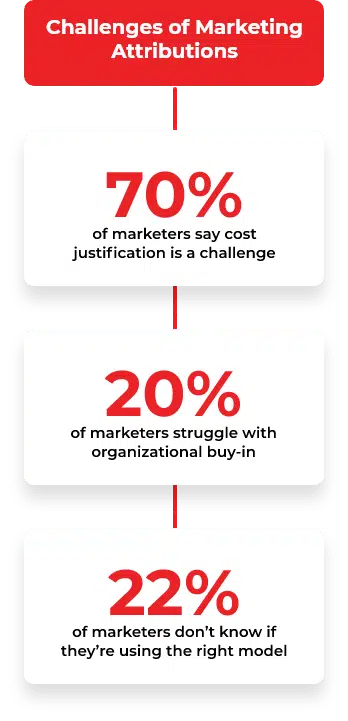Do you need an attribution model for your HCP campaigns?
Well, consider this:
An HCP is on their way to work. While in the car, they listen to their favorite podcast. Once they get there, they pick up their tablet and scroll through electronic health records (EHRs) to get up to date on their first few patients. During their appointments, they visit endemic websites to research treatment and medication options. During their lunch break, they track their nutrition on MyFitnessPal and scroll through The New York Times’ app. On their way home, they listen to their favorite music on Apple Music or Spotify. Once they’re home, they sit down with their family and stream video content via CTV devices and OTT technology such as Hulu, Roku, or Amazon Fire TV. And then they do it again the next day and the day after that. You get the point.
Due to the complex nature of the digital-first world, your digital campaigns have to account for all these touchpoints. Right now, you may only be measuring the first and last click on the path to conversion—that’s the way it’s always been done. However, there’s more that goes into a conversion than these two interactions. An attribution model is the only way to validate your digital advertising initiatives across all of these touchpoints and alleviate the pressure of proving that your campaigns are working.
This article covers everything you need to know about attribution models and why they’re vital to HCP campaigns.
What’s An Attribution Model?
An attribution model is a framework that determines how credit for conversions is assigned to digital touchpoints. Said another way, they help you understand which marketing initiatives someone interacted with before converting, e.g., clicking on your ad, watching a video ad, downloading an ebook, visiting your website, requesting a demo, etc., and which one(s) had the greatest influence.
Why Are Attribution Models So Important?

Attribution models are essential for digital advertising success and sustainability. For better or worse, HCPs are using more technology than ever before—both in and out of the workplace. The average person has access to over ten connected devices.1
This cross-channel and cross-device behavior, which will only become more complex, means that your digital strategy must account for all of these touchpoints. This means that your strategy should allocate spend to some mix of CTV and OTT, social, digital display, mobile, apps, and so on.
Once your campaigns are up and running, you have to make sense of everything, track performance holistically, and get an understanding of which tactics are working. The right attribution model is the only reliable way to do this.
What Are the Different Types of Attribution Models?
The types of attribution models have increased over time. While a one-touch attribution model, which gives credit to a single touchpoint during the purchase journey, worked in the past, the cross-channel nature of today’s online world makes that model ineffective. Today, various attribution models exist, including advanced ones that attribute conversions to multiple touchpoints across someone’s path to purchase.
Last-Click Attribution
Last-click attribution gives 100% of the credit to the last click before a conversion. For example, if an HCP requested a demo by clicking on a display ad, that ad would receive all the credit.
First-Click Attribution
First-click attribution gives 100% of the credit to the first action someone took on their path to purchase. For example, if an HCP downloaded a medical kit on your website, all the credit would go to their first interaction—say, seeing a banner ad or visiting your website’s homepage.
Linear Attribution
Linear attribution gives equal credit to every digital touchpoint before the conversion. If an HCP sees one of your ads, reads an email, and visits a product page before requesting a demo, each of those touchpoints will receive 25% of the credit.
Time Decay Attribution
Time decay attribution gives the touchpoint(s) that occurred closer to the time of the conversion more credit than those that happened further back. If someone visited your website six months ago but didn’t convert, but came back last week and converted after seeing one of your CTV ads, the CTV ads would receive more credit.
Position-Based Attribution (U-Shape Attribution)
This type of attribution gives the most credit to the first and last touchpoint (they each receive 40%). Said another way, if someone’s first and last interaction before converting were with one of your display ads, those ads would each receive 40% of the credit, with the remaining credit (20%) distributed equally among the other touchpoints.
What Are the Challenges of Marketing Attribution?
Despite the need for attribution and the prominence of these models —76% of marketers have or will have the capabilities necessary to use marketing attribution—challenges exist, specifically regarding cost, organizational buy-in, and knowledge.1
-
They Can Cost A lot
Attribution models can be expensive from a financial and bandwidth perspective, which means getting one up and running will require you to pull resources from somewhere else. In a performance-driven world where leadership expects quick results, this can be an intimidating move. Seventy percent of marketers say cost is a challenge.2
-
It’s Hard to Get Organizational Buy-In
Getting the leadership team, especially those outside of the marketing team, to buy into marketing attribution can be tough. A study by NextRoll found that 20.2% of marketers struggle with this.3
-
There’s a Knowledge Gap
HCP attribution isn’t easy, and it’s only becoming more challenging as cross-channel behaviors become the norm. Due to the complexity and knowledge gap, picking the right attribution model isn’t easy—only 22% of marketers say they’re using the right attribution model.4
Moving Forward with the Right Attribution Model
According to a study, first-click and multi-touch attribution are the most popular, used by 45.3% and 43.2% of marketers, respectively.5 However, for HCP campaigns, it’s better to adopt a multi-touch attribution model, e.g., linear attribution, time decay attribution, and position-based attribution.
3 Benefits of Multi-Touch Attribution Models
-
They’re Cross-Channel Friendly:
A multi-touch attribution model is the only reliable way to track performance across all of the digital touchpoints you’re using in your HCP campaigns.
-
They Help Justify Increasing Budgets:
As the digital ecosystem grows, your budgets will have to as well. Not only will this expansion be necessary to compete, but it’ll give you the ability to invest in new ecosystems. The only way to do this is by using an attribution model that proves their impact.
-
They Maximize Spend:
You can’t afford inefficient ad spending. A multi-touch attribution model is the only way to understand the performance of these unique channels and provide you the insight you need to make smart investments that don’t waste your budget. According to a study, proper attribution provides efficiency gains of 15-30%.6
Whatever way you look at it, you need a reliable way to track performance. In 2021 and beyond, a sound attribution model, especially one of the multi-touch varieties, will be a key cog in keeping your marketing engine running at peak performance.
Sources
- Vailshery LS. Average number of connected devices in households worldwide. Statista. Published January 22, 2021. Accessed May 5, 2021.
- Casey C. The hidden challenge with moving to data-driven attribution—and how to overcome it. Think with Google. Published December 2017. Accessed May 5, 2021.
- Keenan J. 37 MIND-BLOWING MARKETING ATTRIBUTION STATS. Leads Rx. Published May 16, 2017. Access May 5, 2021.
- Kennedy G. Challenges in digital attribution measurement. NextRoll. Published July 1, 2015. Accessed May 5, 2021.
- Benes Ross. Five Charts: The State of Attribution. eMarketer. Published December 3, 2018. Accessed May 5, 2021.
- Langford R. The rise of cross-channel attribution: Shifting staff is key [INFOGRAPHIC]. Netimperative. Published May 20, 2016. Accessed May 5, 2021.


